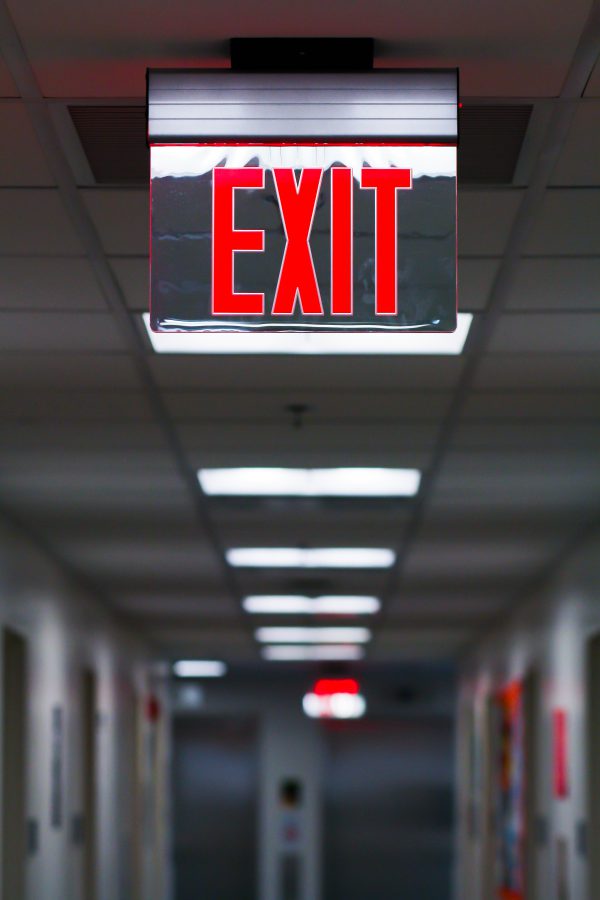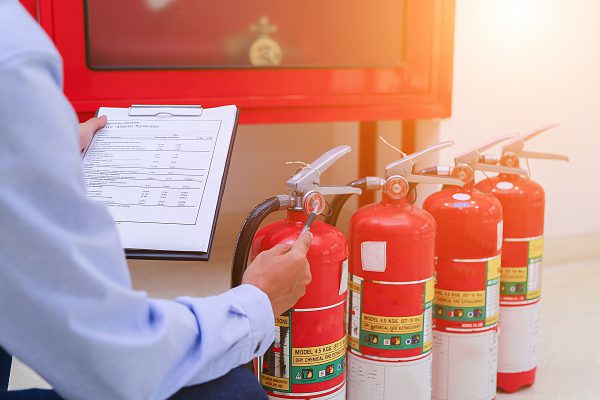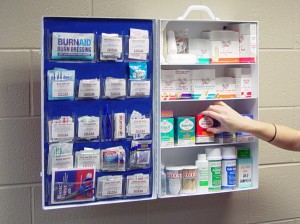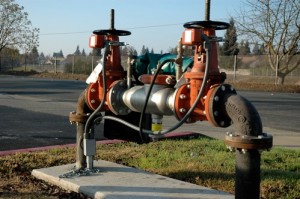-
August 31, 2019 by Total Fire and Safety

Once again active shooting in public places is making headlines and making us consider our self defense options wherever we go. Unfortunately, our safety can be threatened almost anywhere, and self-defense is important. In your workplace or the facilities you manage, it’s important for the people inside to know how to react in the event of an active shooter or other attack.
In the case of an active shooter or other violent attack, potential victims have little or no advance warning. The sound of gunshots may be the earliest alert you receive, leaving little time to react. That’s why it is more important that you are prepared with a proactive plan of self defense, so you know how to respond immediately.
For years we were taught to shelter in place and wait for first responders. But studies have found that this line of defense results in increased casualties. Recently, offices and buildings have adopted the ALICE response plan. ALICE is an acronym for the five steps you can take to survive an active shooter attack. You may or may not use all the steps in the plan, but it’s nice to know that the fire extinguishers we regularly install and service, can actually be used effectively against an attacker in the “C” or “counter” step of ALICE.
So, in the event of an attack, remember ALICE:
- Alert- Let everyone in the office or the building know what is going on when you hear gunshots, receive a warning or phone message, etc. The faster you communicate, the more lives can be saved.
- Lockdown- If evacuation is not an option, lock the door, barricade it, and cover windows. Look for alternate escape routes, call 911, but do not open the door. Prepare yourself for the shooter to enter.
- Inform- Pass on as much information as you can. Who, what, where, when! The more those around you know, the better.
- Counter- Counter is one of the most dangerous but potential life saving strategies within the ALICE response. To counter is to fight back. Even in schools, there is one weapon, available to all, allowed and required in all buildings, and easy to use at your disposal against a predator. It’s your FIRE EXTINGUISHER!
While any object can become a weapon against the shooter, that five or ten-pound fire extinguisher on the wall can be very powerful. Remember that an armed assailant will not have a free hand to block counterattacks, nor will they be expecting one. Use your fire extinguisher to throw at the shooter or as a bludgeon when he comes through the door. Even if hitting him over the head does not knock him unconscious, it can buy you time to escape. You can also pull the pin and deploy the contents which can potentially blind or suffocate the shooter, or at the very least, startle him/her, long enough to disarm or tackle them.
To use a fire extinguisher, remember PASS:
- Pull the pin. Hold the extinguisher with the nozzle pointing away from you and release the locking mechanism.
- Aim low. Point the extinguisher at the base of the fire.
- Squeeze the lever slowly and evenly.
- Sweep the nozzle from side-to-side.
Once the can is empty, keep your grasp and ram the bottom of the can into the attacker’s face or body. Having training on how to correctly use a fire extinguisher ahead of time can ensure that your employees are prepared for more than fighting fires!
If you automatically locate the nearest escape doors when you go into a public place, it’s also a good time to note where the fire extinguishers are located, just in case.
The last letter in the ALICE acronym is “E.”
- Evacuate- Escaping the danger zone is always the best self defense option in the event of a shooter. Total Fire & Safety offers emergency evacuation and fire safety training so your people are trained to respond in a productive, organized way should an emergency ensue.
Total Fire and Safety is committed to all areas of life safety, including self defense against active shooters. For more information on our training, see our website or give us a call: 630-960-5060.
Category: Business Safety, Fire Extinguishers, Fire Extinguishers, Fire Safety, Health and Safety Tags: employee training, fire and safety equipment, Fire Extinguisher, fireextinguisher, Fireextinguishertraining, firesafetytraining, lifesafety, safety, Self Defense, Total Fire and Safety | Comments Off on When Self Defense Meets Fire Safety
-
September 19, 2018 by Total Fire and Safety

Campus fire safety is not likely a hot button issue with college students or parents when they first move on campus. But fires occur on college campuses more than parents and students realize. According to The Center for Campus Fire Safety, between 2000-2018, more than 92 fatal fires killed 132 people on college campuses, Greek housing, or off-campus housing within three miles of college housing. The NFPA reports that U.S. fire departments responded to an average of 3,870 fires in dormitories and Greek housing from 2009 to 2013. Cooking equipment accounts for 86 percent of the fires.
Most dormitories have specific rules and regulations in place to reduce the possibility of fire, but sometimes drugs and alcohol consumption can inhibit a student’s ability to recognize danger zones. It’s worth mentioning to your child that special care must be taken with the following items, even when they allowed by residence:
- Space heaters
- Candles
- Stovetops
- Cooking utensils
- Smoking
- Overloaded power strips
When you move your child in, you can help keep them safe by keeping fire safety in mind:
- Check for smoke alarms and fire sprinklers. These should be located in hallways, lobbies, bathrooms, bedrooms, etc.
- Look for a posted escape route. If there are no plans posted, make one.
- Check with school officials when and how often fire drills are planned. There should be fire drills on-campus, in Greek housing and off-campus housing.
- Keep all exits clear for a safe escape path.
- Do not use flame candles, opt for battery operated candles.
- Practice fire safety in the kitchen. Do not leave food cooking unattended and do not cook when tired or in a compromised state. Unplug appliances. Do not put out grease fires with water.
- Do not overload outlets.
- Turn off electronics and appliances, like computers, hair tools, etc. Hit the off button when leaving the room.
- Clean the lint trap from the dryer, before and after each use.
- Smoke outside! Do not dispose of cigarettes, etc. in the garbage.
Unfortunately, one of these potential fire hazards became real when a mother lost her daughter in a fire while she was attending Reed College near Portland, Oregon. Because of this tragedy, the victim’s mother partnered with the Portland Fire and Rescue to promote the “Zero Death Initiative.” The program aims to educate students, who are on their own for the first time, about fire safety.
Starting college is a big step into a new world for everyone but campus fire safety should not be lost in the fray. Take the precautionary measures now so your child can stay focused on the year ahead. Total Fire and Safety keeps residential buildings equipped and compliant with proper fire code regulations. To find out more about what we do, give us a call at 630-960-5060.
Category: Fire exits, Fire Extinguishers, Fire News, Fire Safety, Total Fire and Safety Tags: emergency exit, emergency exit lights, escape route, fire and safety equipment, fire drill, Fire Extinguisher, fire safety, Firesprinkler, safety, smoke alarms | Comments Off on Parent’s Guide to Campus Fire Safety
-
May 30, 2018 by Total Fire and Safety

Most companies understand the mandate to have regular fire extinguisher inspections but many wonder why on earth a company could actually fail these inspections. After all, a fire extinguisher is rarely used so how can it need service?
Chances are you see a fire extinguisher every day, but how closely do you look at it? Even one dent in the tank can change the outcome. According to the NFPA, nearly 30 percent of fire extinguishers are not in proper working order. Total Fire and Safety’s twelve-point check can ensure your company’s compliance. However, there are five main reasons why companies fail a fire extinguisher inspection.
1. Unseen Damage– Corrosion or damage can occur over time in hard to see areas of the extinguisher, for example, rust within the tank. That is when a professional steps in and inspects the extinguisher inside and out. TFS will visually examine the extinguisher making sure it is free of dents, rust, or other hazards.
2. Potential Hose Blockage– Debris can clog the hose or deterioration of the O-rings can occur over time, rendering a fire extinguisher useless in an emergency. TFS will remove the hose completely to check for irregularities.
3. Possible Leaks– Whether large or small, a leak will cause the fire extinguisher to be inoperable. Anyone can check the pressure gauge to determine if there is a leak. However, if there is no pressure gauge, you will need a professional. TFS will confirm the compression in the tank.
4. Wear/Fading of Labels– Labels are vital when fighting a fire because they contain instructions on how to use the extinguisher. They also provide important information about the device’s maintenance history, which is needed by inspection professionals. Once your fire extinguisher inspection is complete, the labels will be updated, and an additional certification tag will be attached.
5. Recharging Needed– Once a fire extinguisher is used, even partially, it will need to be recharged immediately. If you fail to recharge the extinguisher, it will fail you in a fire.
Although these are common reasons companies fail fire extinguisher inspections, there are other possible hazards not listed. It is important to stay up-to-date with your fire extinguisher inspections. The NFPA requires inspection every month and maintenance every year by a professional. In addition, a stored pressure extinguisher requires internal maintenance every six years and a hydrostatic test every 12 years.
It takes a minute for a fire to spread and cause irreparable damage to your company—the same amount of time it takes to schedule a fire extinguisher inspection!
Total Fire and Safety can inspect your fire extinguishers to ensure they are unfailingly ready to fight fire at a moment’s notice. We also provide onsite training for your employees, including hands-on practice in the use of a fire extinguisher. Give us a call today at 630.960.5060.
Category: Business Safety, Fire code violation, Fire Equipment Inspections, Fire Extinguishers, Fire Extinguishers, Fire Safety, NFPA Compliance, Total Fire and Safety Tags: equipment, Extinguisher, fire and safety equipment, fire and safety needs, Fire Extinguisher, fire extinguisher inspections, fire safety, safety, Total Fire & Safety, Total Fire and Safety | Comments Off on Why Companies Fail Fire Extinguisher Inspections
-
March 15, 2018 by Total Fire and Safety
 Nobody thinks much about emergency exit lights. But if the power suddenly goes out, smoke fills the room and you can’t see a foot in front of you, relying on the emergency lights may be your only means of escape. Nobody thinks much about emergency exit lights. But if the power suddenly goes out, smoke fills the room and you can’t see a foot in front of you, relying on the emergency lights may be your only means of escape.
Emergency exit lights are essential to safety in any dangerous situation. They can alarm someone in a fire, be the only source of light in the dark, and the key to safely exiting the building. Emergency exit lights are often overlooked and taken for granted, but take note of how many you come across every day. Do you realize how many requirements and regulations go into the installation and maintenance of one exit sign?
There are numerous agencies that govern emergency exit lighting and signs: OSHA (Occupational Safety and Health Administration), NFPA (National Fire Protection Administration, JCAHO (Joint Commission on Accreditation of Healthcare Organizations and the International Building Code and International Fire Code. Above all these agencies, the local authority is responsible for monitoring and enforcing building/fire codes.
According to OSHA, an exit route is defined as a continuous and unobstructed path of exit travel from any point within a workplace to a place of safety. There are three parts to an exit route:
- Exit access-part of the exit route that leads to an exit.
- Exit-part of the exit route that is separated from other areas and provides a safe means of travel to exit discharge.
- Exit discharge-part of the exit route that leads to directly outside or refuge area.
OSHA’s requirements for the lighting of these afore mentioned exit routes is covered under 1910.37(b). It states that each exit route must be sufficiently lighted so an employee with normal vision can see along the exit route and each exit must be clearly visible and marked by a sign reading “EXIT.” Additional information for OSHA requirements can be found at www.osha.gov.
The NFPA guidance for emergency exit lighting and signs can be found in the NFPA 101, Life Safety Code. The NFPA’s Life Safety Code provides information for placement, illumination, and visibility for exit signs.
- Placement of exit sign. Any exit signs must be located so that no point in an exit access area is more than the sign’s viewing distance, or 100 feet from the nearest sign.
- Visibility of exit signs-Every sign must be located and of such size, distinctive color and design that is visible and contrasts from the background of its placement. NFPA also states no decorations, furnishings, or equipment that impairs visibility of a sign shall be permitted. Nothing should be placed near an exit sign that distracts attention and inhibits visibility of an exit sign.
- Illumination of Exit Signs-The NFPA states all exit signs must be illuminated by a reliable light source and legible in normal and emergency exit lighting modes. There are two categories of illumination: external illumination, which comes from outside the exit sign and internal illumination, which comes from a source inside an exit sign.
According to the NFPA, emergency illumination must be provided for a minimum of 1.5 hours in the event of power outage. The emergency lighting must be illuminated not less than an average of one lumen per square foot. The maximum illumination at any point can be 40 times the minimum illumination. All emergency exit lighting must be able to provide lighting automatically when normal light is interrupted.
Many emergency exit lights are now using LED lights. The NFPA states that LED lights are longer lasting, provide better light and are most durable. In emergency situations, LED lights emit sufficient lighting and are most effective when placed properly. They are also most energy efficient, saving the building money.
According to the NFPA requirements for testing, there are three categories of emergency lights: traditional, self-testing, and computer base self-testing. A monthly activation test which involves having the lights illuminate for no less than 30 seconds and an annual test which keeps the lights illuminated for 1.5 hours, simulating a long-term emergency. Records of these test must be maintained for inspection.
Many regulations, codes, and considerations go into the signs and lights you see every day so it is important to have regular maintenance and testing of these lights. Total Fire and Safety has a knowledge team for inspecting emergency exit lighting. With regular maintenance and testing from Total Fire and Safety, you can be assured your emergency exit lighting is up to code and the safety of your employees/tenants is assured. Give us a call today 630-960-5060.
Category: Business Safety, Fire code violation, Fire Equipment Inspections, Fire exits, Fire News, Fire Safety, Health and Safety, LED Lighting, NFPA Compliance, Total Experience, Total Fire and Safety Tags: commercial fire protection, commercial fire safety, emergency exit lights, emergency lighting, fire and safety equipment, fire and safety needs, fire and safety solutions, fire safety in the news, fire safety solution, fire safety training, lifesafety, safety | Comments Off on Are You In the Dark About Emergency Exit Lights?
-
April 19, 2017 by Total Fire and Safety

We cannot overstate the importance of first aid requirement for the workplace. If you read through the OSHA requirements for first aid kits and first aid training, and the ANSI minimum first aid equipment for businesses, you may notice that a lot of the details are left up to the business owner. That is because every business is different, and will have different risks depending on the equipment involved in the business. A simple office space might have a small, basic first aid kit, while a car mechanic would probably need a much more complex one. Here are five steps to help guide you through the process of determining what first aid kit and training your business and your employees need.
1. What are the most common injuries in your industry? Think about the equipment involved with your industry, and what kind of accidents can happen with that equipment. Make sure you satisfy the first aid requirement for workplace accidents to handle the most probable injuries within your specific business.
3. How close are you to the nearest hospital or medical center? In the event of an emergency, how long would it be until help arrived? If your business is in a remote location, you might need extra first aid materials to handle an emergency for a longer length of time.
4. How many employees do you have? Make sure there are enough first aid kits to handle an emergency where multiple people are injured. The more employees you have, the more first aid kits you should have.
5. Consider the layout of your workplace. Make first aid kits easy to get to, and easy to see. They must be clearly labeled, and all employees should know where they are. Also make sure that the first aid kits are accessible in the areas which are most prone to accidents, such as the kitchen in a restaurant.
There are a lot of options for both first aid kits and training. Make sure to think about restocking first aid kits and offering training to new employees. First aid requirements for workplace accidents can include portable kits or wall mounted kits, designed for indoor or outdoor use. For first aid training programs, make sure you go with a quality program that will teach your employees how to handle emergencies that are most likely to occur in your workplace. Cover the basics, and go beyond, to keep your employees healthy and safe.
If you have questions or concerns about first aid kit or training compliance, Total Fire and Safety is you one-stop source for all fire safety and first aid needs. Feel free to contact us at 630-960-5060.
Category: Uncategorized Tags: commerical first aid, commerical first aid kit, fire and safety equipment, fire and safety needs, fire safety, first aid, first aid kit, first aid safety, first aid supplies, safety, Total Fire & Safety | Comments Off on Five Questions to Ask to Assess Your First Aid Requirement for Workplace
-
October 21, 2015 by Total Fire and Safety
 Backflow prevention systems are a must for any commercial building with large sinks, photo developing equipment, dishwashers or other machines where contaminated water is prone to backflow. Backflow prevention, sometimes known as a cross-connection control device, keeps contaminated or polluted water separate from drinking water. It is important for fire prevention systems because any water used in fighting a fire or commercial fire sprinkler systems should be potable. Backflow prevention systems are a must for any commercial building with large sinks, photo developing equipment, dishwashers or other machines where contaminated water is prone to backflow. Backflow prevention, sometimes known as a cross-connection control device, keeps contaminated or polluted water separate from drinking water. It is important for fire prevention systems because any water used in fighting a fire or commercial fire sprinkler systems should be potable.
Like any water safety system, there are also building codes that require installation of backflow prevention devices and there are specific types of backflow prevention devices that are required by code. The backflow prevention system is necessary when water is kept at high pressures to enable water flow. If the pressure fails due to an emergency (such as a broken pipe), undesirable solids, liquids, or gases may be sucked into the clean water supply.
Backflow prevention devices use an air gap, or an assembly of valves or pressure vacuums to regulate cross-connection of drinking and contaminated water systems. When drinking water and contaminated water systems meet in certain intersections of piping, the clean water must move into the contaminated water, not the other way around. If the system fails, contaminated water can backflow into clean water as the contaminated water moves to an area of lower pressure. Just as the suction of a straw directs liquid to its proper destination, so the prevention backflow system is needed to prevent cross contamination.
Since backflow prevention is an emergency system, inspection is required on a regular basis. Without regular inspection and installation, a faulty system could endanger the lives of people who drink water connected to the systems. In the past, a lack of working backflow prevention has even led to contamination of entire towns!
The installation, inspection and certification of backflow prevention systems should always be handled by professionals who are experienced with such systems. If you have questions regarding your backflow prevention system, contact Total Fire & Safety for more information.
Category: Fire Safety, Sprinkler Systems, Total Fire and Safety Tags: backflow, backflow prevention, building code, cross connection control, cross-connection, plumbing, plumbing device, plumbing questions, safety, valves | Comments Off on Why Your Backflow Prevention Device is Important
-
October 24, 2014 by Total Fire and Safety
 Halloween is upon us, and although we don’t light jack o’lanterns or don flammable costumes in our offices, it’s important for owners of residential buildings to be somewhat prepared for this fire prone holiday. Halloween is upon us, and although we don’t light jack o’lanterns or don flammable costumes in our offices, it’s important for owners of residential buildings to be somewhat prepared for this fire prone holiday.
According to the National Fire Protection Association, decorations start more than 1,000 home fires per year. From 2006-2010, these fires caused an estimated average of six civilian deaths, 53 civilian injuries, and $16 million in direct property damage per year. For owners of residential buildings and their tenants, there are many good tips on Halloween fire prevention available from NFPA’s Halloween Safety Tip Sheet. It’s information worth passing on to your residents so they stay safe this holiday.
What can owners of residential buildings do to prepare for Halloween?
Fire Alarms in Residential Buildings
Make sure your fire alarms, including your wireless fire alarm monitoring systems, are in working order and in compliance with the National Fire Protection Association (NFPA) 72, which provides the latest safety provisions to meet society’s changing fire detection, signaling, and emergency communications demands.
Fire Extinguishers in Residential Buildings
When is the last time you had your fire extinguishers inspected? NFPA 10 states that all portable fire extinguishers should be inspected on a monthly basis and maintained by a licensed fire protection company on an annual basis. Total Fire & Safety performs a multi-point check on all portable fire extinguishers:
*Visual Examination for dents, rust, corrosion, pitting or other shell damage
*Test/Maintenance History to determine the need for internal maintenance or hydrostatic testing
*Pressure Gauge check to insure proper pressurization
*Weight check to verify the correct amount of extinguishing agent
*Discharge Hose inspected for blockage or damage
*Locking Pin inspected so it can be easily deployed in an emergency
*Handle/Lever checked for smooth discharge operation
*Cleaning using a degreasing solution
*Inspection Certification documented by attaching a safety flag and service tag
*Mounting Bracket checked for proper installation on mounting hook or bracket
*Hazard Application reviewed so the fire extinguisher is the correct type for potential fire hazards
Residential Sprinkler Systems
In the event of a fire, the sprinkler systems are critical. Make sure they are recently inspected and ready to go in compliance with NFPA 25-2002. Total Fire & Safety does a comprehensive check of residential sprinkler systems, including inspection of functionality, control valves, and electric alarm operation.
If you own a residential building, be sure your fire safety is up to standard this Halloween. If you need assistance, feel free to call Total Fire & Safety at 630.960.5060.
Category: Fire Alarm Monitoring, Fire Safety, Uncategorized Tags: fire and safety equipment, fire and safety needs, firesafety, holiday fire safety, holiday safety, safety | Comments Off on Halloween Safety Tips for Residential Buildings
-
March 12, 2013 by admin
Using state of the art technology, our Total Fire & Safety service team uses custom built reports that include voice data, photos, and apply all AHJ and state applicable codes. This ensures that your
company’s fire protection equipment has been tested properly.
Our service technicians go through extensive training in order to receive their state certifications. We hold regular in house safety meetings and continuous education programs to ensure that our technicians are always up to date on all the newest codes and standards.
In fact, our management team does regular onsite audits to ensure the job has been done correctly.
12-Point Portable Fire Extinguisher Service Check:
- Visual Examination: performed on the entire unit, carefully inspecting for dents, rust, corrosion, pitting or other shell damage
- Test/Maintenance History: reviewed to determine the need for required internal maintenance or hydrostatic testing
- Pressure Gauge: checked to ensure that the unit is fully pressurized
- Weight: the extinguisher is checked to ensure the correct amount of extinguishing agent is in cylinder
- Discharge Hose: removed to inspect for signs of blockage or damage
- Locking Pin: removed to ensure that the pin is easily removed in the event of an actual fire emergency
- Handle/Lever: checked for smooth discharge operation
- Clean Extinguisher: using a degreasing solution
- Inspection Certification: documented by attaching a safety flag and service tag indicating the work performed
- Extinguisher: returned to the proper location
- Mounting Bracket: checked to ensure extinguisher is installed securely on correct mounting hook or bracket
- Hazard Application: reviewed to make sure that the fire extinguisher is the correct type for a potential fire hazard
Category: Fire Extinguishers, Fire Safety Tags: businesssafety, equipment, Extinguisher, fire, Fire Extinguisher, fireextinguisher, safety, technology, training | Comments (1)
-
February 21, 2012 by admin
Welcome to the Total Fire and Safety Blog. Here you can get more information on keeping yourself, your children and your property safe from fire and disaster with easy preventative steps. Also should an emergency arise, Total Fire and Safety can educate you, your family or your employees on what to do, where to go and how to keep yourself and others safe in an emergency.
There is lots of safety equipment and technology that can prevent disasters as well as minimize the damages. These technologies are all available through Total Fire and Safety:
- Fire Alarms
- Sprinkler Systems
- Fire Pumps
- Backflow Prevention Plumbing
- Fire Extinguishers
- Emergency Lights
- Fire Suppression Systems
- First Aid
Also Total Fire and Safety offers full training courses on all of our technologies and equipment to be utilized properly in an emergency situation.
Category: Total Fire and Safety Tags: commercial fire protection, commercial fire safety, equipment, fire, fire and safety equipment, fire and safety needs, fire and safety solutions, fire safety solution, lifesafety, safety, technology, Total Fire & Safety, training | Comments Off on Total Fire and Safety Blog
|

|
|
|
|
|
|

 Facebook
Facebook
 Instagram
Instagram
 LinkedIn
LinkedIn


 Nobody thinks much about
Nobody thinks much about 


